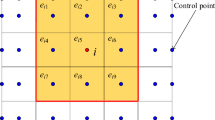Abstract
In CAD/CAM integrated environment, parametrically defined free-form surfaces may require to be truncated to suit the profile of an object to be machined. In such a case the truncated surface needs to be parameterized anew according to the boundaries. Bilinear Coons parameterization is a well known algebraic method which can be used for generating boundary-fitted iso-parametric curves depending on the boundary information. In this paper an iso-parametric tool path generation scheme has been presented based on Coons parameterization technique for free-form surface. The scheme has been tested on some typical surfaces. Limitations in application of this scheme have also been discussed in this paper.





Similar content being viewed by others
References
Coons, S. A. (1964). Surfaces for computer-aided design of space figures. MIT ESL, 9442-M-139.
Ding, S., Yang, D. C. H., & Han, Z. (2005). Boundary-conformed machining of turbine blades. Proceedings of the Institution of Mechanical Engineers, Part B: Journal of Engineering Manufacture, 219, 255–263.
Elber, G., & Cohen, E. (1994). Toolpath generation for freeform surface models. Computer-Aided Design, 26(6), 490–496.
Farin, G. (1988). Curves and surfaces for computer aided geometric design, A practical guide. London: Academic Press Inc.
Faux, I. D., & Pratt, M. J. (1979). Computational geometry for design and manufacture. Chichester: Ellis Horwood.
George, K. K., & Babu, N. R. (1995). On the effective tool path planning algorithms for sculptured surface manufacture. Computers & Industrial Engineering, 28(4), 823–836.
Hoffmann, K. A. (1989). Computational fluid dynamics for engineers. Austin: Engineering Education System.
Huang, Y., & Oliver, J. H. (1994). Non-constant parameter NC tool path generation of sculptured surfaces. The International Journal of Advanced Manufacturing Technology, 9, 281–290.
Jung, J. Y., & Ahluwalia, R. S. (2005). NC tool path generation for 5-axis machining of free-formed surfaces. Journal of Intelligent Manufacturing, 16, 115–127.
Lasemi, A., Xue, D., & Gu, P. (2010). Recent development in CNC machining of freeform surfaces: A state-of-the-art review. Computer-Aided Design, 42, 641–654.
Li, C. L. (2007). A geometric approach to boundary-conformed tool path generation. Computer-Aided Design, 39, 941–952.
Li, H., & Feng, H. Y. (2002). Constant scallop-height tool path generation for three axis sculpture surface machining. Computer-Aided Design, 34, 647–654.
Loney, G. C., & Ozsoy, T. M. (1987). NC machining of free form surfaces. Computer Aided Design, 19(2), 85–90.
Marsh, D. (2005). Applied geometry for computer graphics and CAD. London: Springer.
Mortenson, M. E. (1985). Geometric modeling. London: Wiley.
Sarkar, S., & Dey, P. P. (2012a). Construction of 2-D parametric surfaces bounded with four irregular curves. International Journal of Computer Aided Engineering and Technology, 4(5), 474–487.
Sarkar, S., & Dey P. P. (2012b). A new boundary interpolation technique for parameterisation of planar surfaces with four arbitrary boundary curves. Proceedings of the IMechE, Part C: Journal of Mechanical Engineering Science, doi:10.1177/0954406212460355.
Smith, R. E. (1983). Three-dimensional algebraic grid generation, AIAA 6th computational fluid dynamics conference. Massachusetts: Danvers.
Stoker, J. J. (1989). Differential geometry. London: Wiley.
Suresh, K., & Yang, D. (1994). Constant scallop-height machining of free-form surfaces. ASME Journal of Engineering for Industry, 116(2), 253–259.
Thompson, J. F., Warsi, Z. U. A., & Mastin, C. W. (1985). Numerical grid generation, foundations and applications. North Holland: Elsevier Science Publishing Co, Inc.
Ülker, E., Turanalp, M. E., & Halkaci, H. S. (2009). An artificial immune system approach to CNC tool path generation. Journal of Intelligent Manufacturing, 20, 67–77.
Wang, C. C. L., & Tang, K. (2004). Algebraic grid generation on trimmed parametric surface using non-self-overlapping Coons patch mapping. International Journal for Numerical Methods in Engineering, 60(7), 1259–1286.
Yamaguchi, F. (1988). Curves and surfaces in computer aided geometric design. Berlin: Springer.
Zhang, L. P., Nee, A. Y. C., & Fuh, J. Y. H. (2004). An efficient CC-curve tool path regeneration algorithm for sculptured surface machining. Proceedings of the Institution of Mechanical Engineers, Part B: Journal of Engineering Manufacture, 218, 389–402.
Author information
Authors and Affiliations
Corresponding author
Rights and permissions
About this article
Cite this article
Sarkar, S., Dey, P.P. Tool path generation for algebraically parameterized surface. J Intell Manuf 26, 415–421 (2015). https://doi.org/10.1007/s10845-013-0799-x
Received:
Accepted:
Published:
Issue Date:
DOI: https://doi.org/10.1007/s10845-013-0799-x




